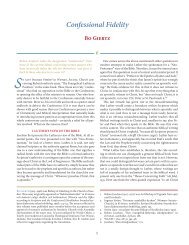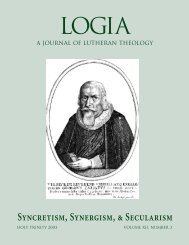The Lord's Supper in the Theology of Martin Chemnitz Bjarne - Logia
The Lord's Supper in the Theology of Martin Chemnitz Bjarne - Logia
The Lord's Supper in the Theology of Martin Chemnitz Bjarne - Logia
You also want an ePaper? Increase the reach of your titles
YUMPU automatically turns print PDFs into web optimized ePapers that Google loves.
| <strong>The</strong> Lord’s <strong>Supper</strong><br />
(“sondern was der Priester <strong>in</strong> der Hand hat”— as quoted by Salig). Salig rhetorically asks<br />
whoever directed Dr. Moerl<strong>in</strong> to state that such doctr<strong>in</strong>e was Lu<strong>the</strong>ran that <strong>the</strong> priest has<br />
<strong>the</strong> body and blood <strong>of</strong> Christ <strong>in</strong> his hand. Salig counters by claim<strong>in</strong>g that Lu<strong>the</strong>r says: <strong>The</strong><br />
body and blood <strong>of</strong> Christ is <strong>in</strong> <strong>the</strong> Sacrament, and outside <strong>the</strong> use (Geniessung) <strong>the</strong>re is no<br />
sacrament. Salig cont<strong>in</strong>ues by assert<strong>in</strong>g that this is what Melanchthon also taught and all<br />
true Lu<strong>the</strong>rans still do, and, on <strong>the</strong> contrary, it is not Lu<strong>the</strong>ran doctr<strong>in</strong>e that apart from <strong>the</strong><br />
use (Geniessung) <strong>the</strong>re is no sacrament. And he asks whe<strong>the</strong>r this is not papistic Artolatry<br />
[i.e., when Moerl<strong>in</strong> holds that Lu<strong>the</strong>r taught that what <strong>the</strong> priest had <strong>in</strong> his hand was <strong>the</strong><br />
body and blood <strong>of</strong> Christ before <strong>the</strong> sumptio.] What else are <strong>the</strong> papists do<strong>in</strong>g when <strong>the</strong>y<br />
lift up (aufstecken) <strong>the</strong> Host from <strong>the</strong> altar or carry it around <strong>in</strong> procession? And now, Salig<br />
laments, Melanchthon must be considered Calv<strong>in</strong>ist because he declaimed aga<strong>in</strong>st this.<br />
This is an important reference for several reasons. It shows that by 1735 <strong>the</strong> position<br />
<strong>of</strong> Aegidius Hunnius (see p. 89 f.) has so completely won out over that <strong>of</strong> <strong>Chemnitz</strong> and<br />
Lu<strong>the</strong>r that <strong>the</strong>ir real position is misrepresented. <strong>The</strong> consecration has been deprived <strong>of</strong><br />
its power and reduced to a general prayer <strong>in</strong> which, rem<strong>in</strong>ded <strong>of</strong> <strong>the</strong> first <strong>in</strong>stitution, <strong>the</strong><br />
communicant prepares himself for a worthy reception.<br />
As has been already demonstrated, Lu<strong>the</strong>r and <strong>Chemnitz</strong> did teach that <strong>the</strong> consecration<br />
achieves <strong>the</strong> Real Presence. <strong>The</strong>refore it is a fair question to ask <strong>the</strong> <strong>of</strong>ficiant what he is<br />
hold<strong>in</strong>g <strong>in</strong> his hand; as a matter <strong>of</strong> fact, it is a good test question to see whe<strong>the</strong>r one accepts<br />
Lu<strong>the</strong>r’s doctr<strong>in</strong>e, just as Moerl<strong>in</strong> evidently had used Lu<strong>the</strong>r’s letter (Sasse translates part<br />
<strong>of</strong> this letter and discusses it <strong>in</strong> This is My Body, p. 229 f.).<br />
Fur<strong>the</strong>r, one realizes how important it is that <strong>Chemnitz</strong>, recogniz<strong>in</strong>g <strong>the</strong> confusion caused<br />
by <strong>the</strong> use <strong>of</strong> such vague terms as “actio,”“usus,”“Geniessung,” <strong>in</strong> connection with <strong>the</strong> Lord’s<br />
<strong>Supper</strong>, precises <strong>the</strong> def<strong>in</strong>ition <strong>of</strong> <strong>the</strong> terms so that <strong>the</strong> precise def<strong>in</strong>ition is <strong>in</strong>corporated<br />
<strong>in</strong>to <strong>the</strong> Formula (SD VII, 85 f.). Salig uses <strong>the</strong> term Geniessung, referr<strong>in</strong>g it only to <strong>the</strong><br />
sumptio. In his view <strong>the</strong> consecration lapses <strong>in</strong>to an unimportant part <strong>of</strong> <strong>the</strong> Sacrament. Of<br />
course, if <strong>the</strong> Real Presence exists only <strong>in</strong> <strong>the</strong> sumptio, <strong>the</strong>n not only is <strong>the</strong> consecration a<br />
conditional element depend<strong>in</strong>g on <strong>the</strong> sumptio by <strong>the</strong> communicant for its effective power,<br />
but it also would be Artolatry to practice veneration <strong>of</strong> <strong>the</strong> Host after <strong>the</strong> consecration<br />
but before <strong>the</strong> distribution, a custom which Lu<strong>the</strong>r and <strong>Chemnitz</strong> deemed permissible.<br />
It need hardly be added that both Lu<strong>the</strong>r and <strong>Chemnitz</strong> condemned <strong>the</strong> Corpus Christi<br />
processions because this is outside <strong>the</strong> use commanded by <strong>the</strong> Savior.<br />
This footnote #2 (toge<strong>the</strong>r with note #4 on p. 1016) <strong>in</strong>dicates that <strong>the</strong> editor <strong>of</strong> <strong>the</strong><br />
Bekenntnisschrift (Dr. E. Wolf ) is sympa<strong>the</strong>tic to a Melanchthonian view <strong>of</strong> <strong>the</strong> Lord’s<br />
<strong>Supper</strong>. <strong>The</strong> Salig reference shows that <strong>the</strong> Melanchthonian view has been consistently<br />
imposed on <strong>the</strong> Formula <strong>of</strong> Concord for nearly 400 years.<br />
Salig, <strong>in</strong> this context, also mentions that Melanchthon was opposed to Heshusius, who,<br />
while at Heidelberg, desired that <strong>the</strong> leftover w<strong>in</strong>e not be put back <strong>in</strong>to <strong>the</strong> canister. Salig’s<br />
o<strong>the</strong>r examples that brought disapproval from Melanchthon <strong>in</strong>cluded <strong>the</strong> demand at Erfurt<br />
for <strong>the</strong> veneration <strong>of</strong> <strong>the</strong> Host, and also <strong>the</strong> practice <strong>in</strong> Schleswig, Frankfort-on-<strong>the</strong>-Oder,<br />
and o<strong>the</strong>r places that <strong>in</strong>sisted so strongly for <strong>the</strong> retention <strong>of</strong> <strong>the</strong> elevation. Salig asserts<br />
that Melanchthon should not be considered a Calv<strong>in</strong>ist when he objected to what Salig<br />
calls papistic fragments, because <strong>the</strong>y were examples <strong>of</strong> Artolatry. Nei<strong>the</strong>r Lu<strong>the</strong>r, nor<br />
<strong>Chemnitz</strong>, nor SD VII, 108 and 126 condemn <strong>the</strong>se Gnesio-Lu<strong>the</strong>rans <strong>in</strong> this practice.<br />
74. See note #59, where Pastor Kenneth Miller rejects <strong>the</strong> <strong>in</strong>terpretation that <strong>the</strong> “This do”<br />
<strong>in</strong>cludes <strong>the</strong> consecration, and thus he limits <strong>the</strong> sacramental union only to <strong>the</strong> time when<br />
some <strong>of</strong> <strong>the</strong> elements are received. <strong>The</strong> sacramental union would not be effected <strong>in</strong> any<br />
o<strong>the</strong>r sacramental elements that may have been upon <strong>the</strong> altar and had come under <strong>the</strong>




